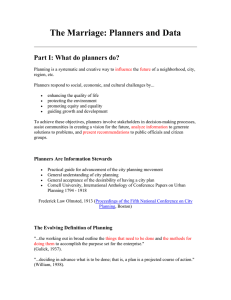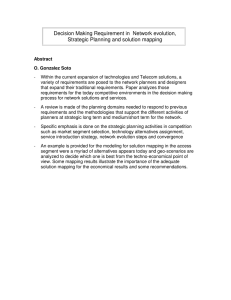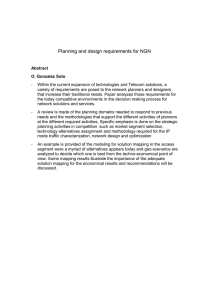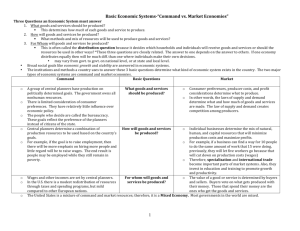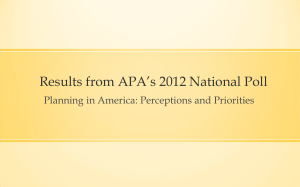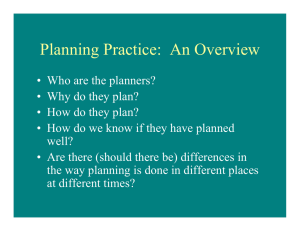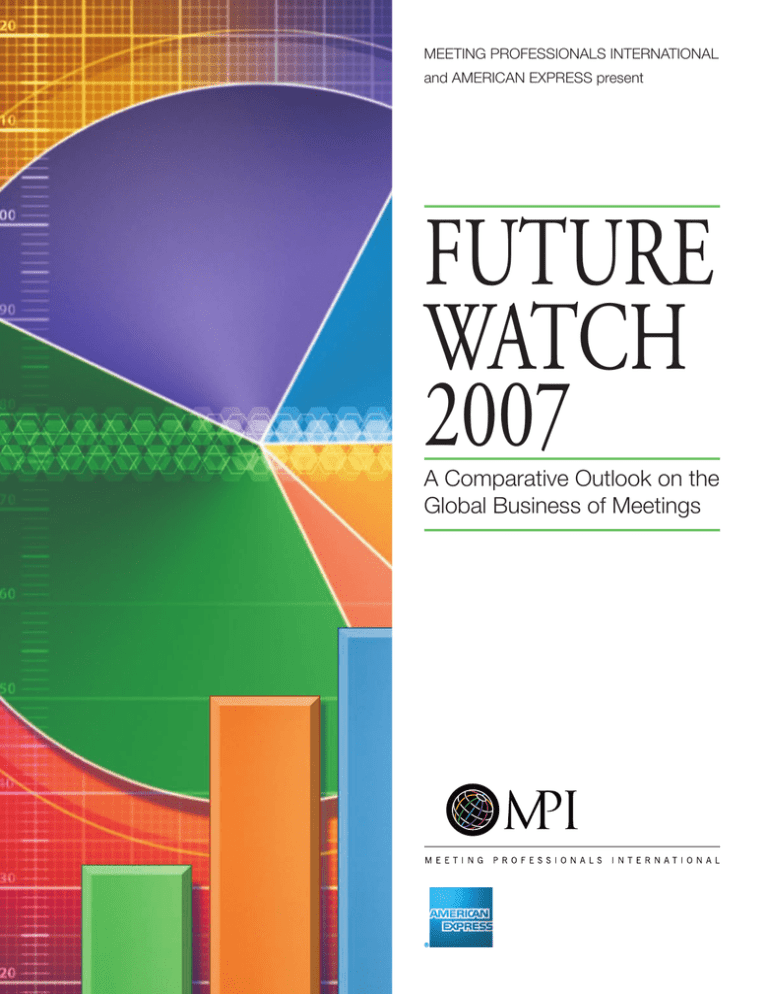
MEETING PROFESSIONALS INTERNATIONAL
and AMERICAN EXPRESS present
FUTURE
WATCH
2007
A Comparative Outlook on the
Global Business of Meetings
F
or the fifth consecutive year,
the annual FutureWatch
survey conducted by Meeting
Professionals International (MPI),
in partnership with American
Express, takes the pulse of the
meetings industry and reports on
industry trends expected for the
coming year.
As in years past, the trends
presented in FutureWatch 2007
reflect the economic and societal
trends impacting the world. In
2004, the meetings, conventions
and incentive travel industry was
estimated to have contributed
more than $122 billion* to the
U.S. economy. If the growth
predicted by FutureWatch
respondents during each of the
past four years has been realized,
then the contribution of the
meetings and events industry will
reach new highs in 2007, both in
the U.S. and around the globe.
FUTURE
WATCH 2007
Based on survey responses from 1,443 meeting professionals,
FutureWatch 2007 provides a portrait of an industry that is strong, thriving
and moving quickly to meet a variety of internal and external challenges.
In this year’s study, we asked planners to report on the
trends internal to their organization, such as:
• Workload
• Budgets
• Shifting organizational goals and strategies
• Centralization of the planning function
• Use of virtual, or webcast, meetings and the current and future
involvement of planning departments in those activities
Planners, suppliers and meeting management and services professionals were
asked to report on the more global trends expected to impact the industry:
• The impact of terrorism and war on business travel
• Various factors impacting the cost of doing business, such
as the cost of oil and gas and general inflation
• Possible economic downturn or recession
• Increasing globalization of both client- and supplier-side organizations
Finally, we asked respondents to identify trends in how planners,
suppliers and meeting management organizations might work
together in tomorrow’s marketplace. Topics include:
• The technologies planners will seek in 2007 and the availability of solutions
• Tomorrow’s outsourcing - what will be outsourced and to whom?
• Where suppliers’ meetings clients reside, whether
within or outside the organization
• The successes and challenges of preferred vendor programs and the
involvement of procurement departments in the purchasing process
• The steps suppliers are taking to build loyalty among their
planner clients, and what planners would prefer
• Location of meetings across regions of the world and types of venues
Use the data and analysis provided in FutureWatch 2007 as a guide to the
changes and growth expected in the meetings industry in 2007 and beyond.
FutureWatch Participants
Client-side planners (441 respondents) include corporate, association, government, non-profit and others planning meetings for clients internal to their organization.
Meeting management and services professionals (180 respondents) or intermediaries, include independent planners, PCOs (professional conference organizers)
and those working for third-party, multi-management, site selection or other meeting services providers.
Meeting suppliers (814 respondents) include meeting facilities such as hotels and resorts, convention and conference centers and unique venues, convention and
tourism bureaus, transportation providers and other onsite service providers such as caterers and production companies.
*Convention Industry Council
FutureWatch 2007: A Comparative Outlook on the Global Business of Meetings 1
Inside Meetings
This look inside the meetings function
assesses expected growth in the
number, size and budget for meetings
along with internal trends impacting
planners. MPI also presents baseline
data addressing the centralization of
the meetings function and the extent
to which total meeting spend is being
calculated at the organizational level.
Meeting Statistic Estimates for 2007
Expected Increase Over 2006
Number of meetings held (organization)
Total budget for meetings
• Although overall meeting
budgets are expected to increase
by 21% for associations and
18% for corporations, spend per
meeting is expected to increase
by only 8% and 4%, respectively.
18%
13%
Number of meetings personally planned
21%
17%
12%
Budget for meetings personally planned
Continued Health in the
Marketplace
Respondents’ expectations for the
coming year paint a picture of
sustained industry growth. Planners
expect to manage more meetings
in 2007 and expect to see larger
budgets, both in dollar terms and as a
percentage of the total organizational
budget.
• Association and corporate
planners expect the number
of meetings held by their
organizations to increase by 18%
and 7%, respectively.
18%
7%
19%
19%
Number of attendees per meeting
2%
1%
Length of meeting in days
Spend per meeting
4%
Number of facilities considered per meeting
4%
0%
5%
8%
n Association/Non Profit
n Corporate
6%
10%
15% 20% 25%
Average % Increase Reported
Share of Corporate Budget Expected for 2007
19%
n A smaller proportion
n A larger proportion
n The same proportion
• Planners expect to see more
attendees at meetings, but do not
expect an increase in the length
of those meetings.
2 FutureWatch 2007: A Comparative Outlook on the Global Business of Meetings
57%
27%
25%
30%
Trends within Organizations
Budget, work load, shifting strategies and changing expectations
With the trend toward more meetings, larger budgets and higher attendance rates
continuing into 2007, it is not surprising that planners identified budget changes
and workloads as two of the factors they expect to have the greatest impact on
their jobs next year. Emphasis on these factors, however, varied by job level and
organization type.
Implication
Although it is a positive sign for the
industry that on average, meetings
and meeting budgets are on the
rise, many planners may still have
budgeting challenges. Of the 46% of
Ranking of Internal/
Organizational Trends Impacting Planner Jobs
planners expecting an increase in the
1.
2.
3.
4.
than half (48%) are expecting their
number of meetings they personally
manage or support in 2007, less
Budget changes within the organization
Workload of meeting planners
Shifting organizational goals and strategies
Changes in the way meetings and events are viewed within the organization
• Respondents with non-managerial titles were more likely to indicate that
department-specific issues like changing budgets and workloads would have
the greatest impact on their jobs.
• Managerial respondents were more likely to emphasize broader organizational
and strategic issues such as shifting organizational goals and strategies and
changes in the way meetings and events are viewed or used within the
organization.
• Association planners expect workloads to impact planners most in 2007,
followed by shifting organizational goals and changes in the way meetings are
viewed and used. Budgets were not ranked as a main concern for association
planners.
personal budget to increase.
When asked what internal
organizational trends were expected
to have the greatest impact on their
jobs, fewer respondents than in
2006 ranked the involvement of the
procurement department as a major
factor. On page 11 planners describe
the successes and challenges of
the partnership between these two
functions.
Budget Change by Meeting Volume Change
Direction of Budget Change
n Budget Increase
n No Change in Budget
n Budget Decrease
24%
42%
29%
48%
68%
49%
37%
54%
29%
8%
Fewer
Meetings
No
Change
4%
More
Meetings
9%
Total
Direction of Meeting Volume Change
FutureWatch 2007: A Comparative Outlook on the Global Business of Meetings 3
Centralization of the
Meetings Function
Although industry professionals have
speculated about the shift toward a
more centralized meetings function
within corporations, very few data
have been collected. This year’s report
provides a baseline against which
future shifts and developments can be
measured.
Centralization of the Corporate Meetings Function
21%
Across the Organization
Across Geographical
Locations or Regions
25%
32%
54%
19%
n Mostly/Completely Decentralized
49%
n Somewhat Centralized
n Mostly/Completely Centralized
Total Organizational
Meeting Spend Currently
Calculated and Reported
55%
15%
30%
n Yes
n No
For those not Currently
Capturing Total Spend,
Expectation for Change
n Do not expect the
organization to move
in this direction
50%
14%
n Don’t know/
not applicable
4 FutureWatch 2007: A Comparative Outlook on the Global Business of Meetings
• 49% of planners reported
having a meetings function that
was centralized across different
organizational locations or
regions.
Calculating Total
Meeting Spend
With more organizations focusing
on return on investment (ROI)
measurements, a baseline was needed
to understand the extent to which
corporations understand what they are
spending on meetings.
• 55% of corporate planners
indicate that total meeting
spend is calculated for their
organization, while 30% say that
it is not and 15% do not know.
• Of those not currently
calculating total spend, 51%
of organizations expect more
emphasis to be placed on this in
the future.
• 68% of organizations with
a more centralized meetings
function calculate the
meeting spend for the entire
organization, compared with
only 27% of organizations with
more decentralized planning.
n I don’t know
n Expect the organization
to move in this direction
• 54% of corporate planners
surveyed indicated that their
meetings function was either
mostly or completely centralized
across the organization.
36%
Virtual Meetings
• Expectations for the use of
webcasts within live meetings
are mixed, with almost onethird expecting to incorporate
webcasts more frequently in
2007 and 29% expecting to do
so less frequently. 39% anticipate
no change.
• While nearly 40% of
respondents expect webcasts to
reduce onsite attendance, onethird believe the total number
of participants (live and virtual)
will actually rise.
• Fewer than 30% of planning
departments are currently
involved in planning virtual
meetings for their internal clients
and fewer than 40% believe that
the meetings department would
be responsible for planning
Impact of Meetings Function Centralization on
Calculating Total Organizational Meetings Spend
n Yes
Does your organization calculate
its total meetings spend?
Although virtual meetings, or webcasts,
are on the rise, most planning
departments are not currently involved
in managing these meetings for their
internal clients and are not likely
to position themselves as the ‘go to’
function for virtual meetings during
the next year.
• 47% of client-side planners
expect the use of virtual
meetings to increase over the
next year, whereas only 20%
expect a decrease.
n No
11%
22%
n I don’t know
16%
22%
21%
31%
33%
52%
68%
53%
45%
27%
Centralized
Somewhat
Decentralized
Total
How centralized is your meetings function?
virtual meetings in the future
if their organization made a
significant move toward using
virtual meetings in place of live
meetings.
• 32% report that their meetings
department is likely to position
itself as the ‘go to’ department
for virtual meetings and
events, although this number
is significantly higher for
association planners (39%) than
for corporate planners (29%).
Implications
Responses suggest that, overall,
webcasts are not yet seen as a
standard part of a meeting planner’s
repertoire. As corporate and
government planners consider what
their involvement in virtual meetings
should be in the future, they should
consider looking to their association
counterparts, who are further
along in their efforts to prepare
for the wider use of virtual events
and position their departments
as a resource for non-traditional
meetings.
FutureWatch 2007: A Comparative Outlook on the Global Business of Meetings 5
Looking Outward
External Trends:
Terrorism, Gas Prices
and Economic Trends
In 2006, planners and suppliers
identified the economy as the external
factor expected to have the greatest
potential impact on meetings and
events, followed by travel costs and
the cost of oil and gas. For 2007,
the impact of terrorism and war on
business travel has surged ahead of
all other concerns, receiving a first-,
second- or third-place ranking from
38% of respondents.
• Behind terrorism and war (the
top concern), increasing costs
are expected to have the greatest
impact on the industry. The
cost of oil and gas is expected to
have the second-greatest impact,
followed by general inflation.
• The fourth- and fifth-ranked
trends were both related to the
economic outlook, with some
predicting that an economic
downturn would impact
them in 2007 and another
group expecting economic
improvement.
• Increasing globalization and
increased access to information
are expected to impact the
meetings industry as well.
• European respondents expect
terrorism and war, increasing
globalization and a positive
economic environment to have
the greatest impact on the
industry in 2007.
Expected Change in Hotel Rates for 2007
Percent of
Respondents
Expecting a Change
in Hotel Rates
• Pharmaceutical planners expect
government regulation to have
the greatest impact during the
coming year.
Top External or Global
Trends Expected to Impact
the Industry in 2007
1. Impact of terrorism and war on
business and travel
2. Cost of oil and gas, including
the impact on travel costs
3. General inflation of costs
73%
4. Current or impending economic
downturn or recession
5. Current or impending economic
upturn or improvement
n Expect a Decrease
n Expect No Change
n Expect an Increase
• Canadian respondents
are most concerned about
the possible impact of the
Western Hemisphere Travel
Initiative’s new passport and
visa regulations, followed
by terrorism and war and a
current or impending economic
downturn. Canadians are
also concerned about health
pandemics and diseases such
as SARS and avian flu.
26%
1%
6. Changes or advances in
technology
7. Increasing globalization (more
vendors and customers across the
globe)
Hotel Rates on the Rise
73% of respondents expect hotel rates
to increase in 2007, while only 1%
expect a decrease and 26% expect no
change. The average amount of the
increase expected is 8%.
6 FutureWatch 2007: A Comparative Outlook on the Global Business of Meetings
Entering the Global Market
• Corporate planners are most
likely to work for organizations
with staff or offices in more than
one country (71%), followed
by those working for a hotel
or resort company (60%) and
meeting management and
services companies (42%).
• Independent and association
planners are least likely to work
for organizations that operate in
multiple countries.
• 27% of all respondents expect
the number of countries in which
they operate to increase in 2007.
• Hotel companies plan to expand
to new countries at the highest
rate (47%), followed by meeting
management and services
companies (36%) and corporate
planners’ organizations (26%).
Number of Countries in which Organization
has Staff or Offices
Percent in each category
100%
80%
60%
57%
40%
27%
20%
7%
9%
2
3 to 5
0%
1
6 or more
Number of Countries
Expansion Plans for 2007 by Current Number of Countries
n Not sure
5%
Plans for Expansion
Globalization is on the rise in all areas
of the meetings industry. Client-side
planners, meeting management and
services companies and especially hotel
and resort companies expect to increase
their global presence in 2007. Those
with a foot in the global market are
more likely than their single-country
counterparts to expand that presence
over the next year.
• Overall, 57% of responding
organizations are located in only
one country. Over half of the
other 43% operate in more than
five countries.
n No Change
13%
n Increase
18%
n Decrease
17%
17%
87%
52%
52%
65%
35%
8%
1
28%
3%
2
3 to 5
1%
6 or more
Current Number of Countries Operating In
• European respondents’
organizations are more likely to be located in multiple countries (56%) and
are more likely to expand operations into other countries in 2007 (44%).
• Organizations operating in five or more countries are
more than eight times more likely than single-country
organizations to expand globally in the next year.
FutureWatch 2007: A Comparative Outlook on the Global Business of Meetings 7
The Middle Ground
Like most industries, the meetings
and events industry is a complex
system made up of interdependent
organizations and functions. As
indicated earlier, this system is
impacted by trends and events within
client organizations and by the
economy and world at large. Together,
the organizations and professionals
within the industry adapt to these
changes and optimize everyone’s
opportunity for success.
Meetings Technology:
A Wealth of Possibilities
Technology is one of the many tools
that planners rely on to help them
execute at the highest level. While
planners are clear about the technology
they will be seeking in 2007, they are
not always as confident that the right
resources will be readily available to
them.
• In 2007, planners will first
and foremost seek technology
and tools to help with meeting
logistics. This includes resource
calculators, room layout tools,
etc. Although 40% feel that
adequate and affordable tools
exist, 23% feel that existing tools
are not affordable or accessible.
to facilitate the RFP process are
least likely to raise cost concerns
(9%). Instead, respondents
either believe adequate RFP tools
do not exist (35%) or that the
tools are available and affordable
(51%).
• Second on planners’ list are tools
to get better attendee feedback
about meetings and events. Half
of respondents feel that adequate
and affordable options are
available to them.
• The five least-sought
technologies for 2007 (of the
technologies listed on the survey)
are tools to:
-Match attendees with relevant
courses, vendors and peers at
an event
• Third most popular are
technologies and tools for
identifying and tracking
meeting attendees (registration
tools, badge solutions, RFID
technologies, etc.). 42% feel that
these tools are not affordable or
accessible to them.
-Facilitate networking on
site (e.g., wireless handheld
devices)
-Share conference content and
course documents
-Provide alternatives to live
meetings (via webcast, etc.)
• Whereas Internet access at
venues and hotels is most likely
to raise concerns about cost
and accessibility (43%), tools
-Allow remote participation in
‘live’ meetings
Top Ranked Technologies for 2007 with Assessments of Availability
n Nothing Adequate
n Not Affordable/Accessible
1. Logistical Planning Technology
(e.g., resource calculators)
2. Attendee Feedback
Technology
3. Technology to improve identification
and tracking (e.g., badges, RFID,
registration tools)
n Available/Affordable/Accessible
30%
20%
5. Technology to facilitate
the RFP process
40%
18%
15%
4. Better access to the Internet
at venues and hotels
23%
29%
12%
36%
43%
9%
8%
23%
51%
Availability of Technologies
8 FutureWatch 2007: A Comparative Outlook on the Global Business of Meetings
7%
50%
42%
35%
n Don’t know/NA
5%
5%
Outsourcing Holds Steady
As found in 2006, client-side planners
predict little change in the number of
meetings they will outsource in 2007.
While planners expect to outsource
15% of their meetings in 2007,
this year’s survey drilled deeper to
determine how client-side planners are
using outside meeting management
organizations and services.
• One-third of outsourced
meetings will be completely
outsourced, whereas two-thirds
are predicted to be partially
outsourced.
• In addition, 69% of outsourcing
by client-side planners will
be for logistical services and
support, compared to only 16%
for strategy. This suggests that
while these planners are prepared
to outsource meeting logistics,
they intend to retain control of
strategic planning and valueadded consulting.
Vendor Selection
Authority over vendor selection varies
widely among meetings industry
decision-makers.
• Overall, intermediary planners
indicate that they select the
vendors for their meetings twothirds of the time, while their
clients select the vendors onethird of the time.
Percent of Events to be Outsourced in 2007
n Partially Outsourced
85%
n Totally Outsourced
n Entirely Internal
10%
5%
What is Being Outsourced by Organizational Type
n Consulting/Strategy
n Logistics/Services
16%
20%
69%
59%
14%
21%
Total Client-side
Association/
Non-Profit Meeting
Professional
n Other
14%
73%
13%
Corporate
Meeting
Professional
FutureWatch 2007: A Comparative Outlook on the Global Business of Meetings 9
Vendors’ Primary Meeting Client Contact
2%
7%
21%
6%
7%
8%
5%
10%
16%
35%
22%
8%
7%
7%
n Other
30%
n Procurement
24%
n Department that Owns the Meeting
7%
48%
2006
39%
42%
2007
2006
Suppliers
17%
31%
• This decrease may reflect the
addition of a new option to
this year’s survey, as opposed
to a strong shift in activity.
Specifically, this year’s survey
allowed respondents to select
non-traditional (non-meetings)
organizations as a main point of
contact. This includes advertising
Percentage of Vendors Considered to be Preferred Vendors
(of companies with a Preferred Vendor Program)
30%
30%
23%
21%
15%
12%
10%
1-25%
n Meetings/Events Department
2007
within the internal meetings
function as their main point of
contact, down from 48% and
42%, respectively versus 2006.
For suppliers and meeting
management and services providers,
meeting professionals are still the
primary contacts within client
organizations when an event is on the
horizon, though meeting management
and services professionals more often
than last year report being engaged by
other intermediary meeting companies
and other types of agencies:
• 39% of suppliers and 31% of
intermediaries identify someone
0%
n Intermediary Meeting Company/Planner
Intermediaries
A Business of Relationships
20%
nOther Type of Company/Agency
(PR, Advertising, etc.)
26-50%
51-75%
10 FutureWatch 2007: A Comparative Outlook on the Global Business of Meetings
76-99%
100%
and public relations agencies that
sometimes handle meetings as
part of a larger contract or area
of responsibility. 7% in both
groups work through this type of
organization.
• 16% of suppliers and 30%
of third parties deal directly
with the department that owns
the meeting, a decrease of 5
percentage points for both
groups versus 2006.
• 8% of suppliers (up from 7% in
2006) and 7% of third parties
(down from 10%) work through
procurement.
A Report Card for
Procurement and Preferred
Vendor Programs
It is widely acknowledged that
procurement or purchasing
departments are playing a more
active role in purchasing decisions for
meetings within many organizations.
In this survey, planners assessed the
prevalence of this involvement and
provide both positive and negative
feedback about the impact of this
involvement.
Prevalence
• 30% of corporate and government planners say procurement plays a major
part in their purchasing decisions and another 34% report some participation.
• 27% of respondents expect purchasing departments to become more involved
with meetings in 2007, while 15% predict they will be less involved.
• 26% of corporate planners do not have a preferred vendor program, while a
surprising 30% are not sure.
• Of companies that do have a preferred vendor program, 63% state that more
than half of their meeting vendors are included in the preferred vendor group.
Only 12% say that all of their meeting vendors are included.
When asked why they rated their
preferred vendor program as being
successful, planners cited the
following reasons:
• Cost savings
• Time savings
• Improved relationships and
partnerships with vendors that better
understand their needs
Expectations for Procurement’s Involvement in 2007
Procurement will be:
27%
More involved in purchasing for meetings
Less involved in purchasing for meetings
15%
More knowledgeable about meetings/helpful
23%
15%
More of an obstacle to producing high-quality events
A better partner/more collaborative
21%
Other
21%
Impact
• 23% of planners believe that
procurement professionals will
become more knowledgeable
about meetings and events
and therefore more helpful to
meetings departments.
• 21% expect procurement
to become a stronger
collaborative partner for meeting
professionals.
• 15% of planners, however,
believe that procurement will
become more of an obstacle
to high-quality, high-impact
meetings in 2007.
• Procurement also is impacting
vendor organizations,
demonstrated by the finding that
36% of meeting management
professionals report that the
involvement of procurement
has influenced their fee
structures. This trend is more
pronounced for larger meeting
management/services companies
(46%) than for smaller,
independent planners (23%).
• 60% of corporate planners
believe that their organization’s
preferred vendor program has
been successful or beneficial
(rating it either a 4 or 5 on a 5point scale).
Planners’* Evaluation of Success of Preferred Vendor Program
n 1=Not at all Successful/Beneficial
4% 8%
n2
n3
29%
n4
n 5=Extremely Successful/Beneficial
38%
22%
*Corporate and government planners
FutureWatch 2007: A Comparative Outlook on the Global Business of Meetings 11
FutureWatch 2007 gathered primary
intelligence on preferred pricing
strategies for meeting management
firms and independent planners. The
following pricing strategies are used
by the percentage of respondents
noted:
• Time-spent fee:
41% of independent planners
24% of meeting management/
services companies
• Fixed project fee:
28% of independent planners
18% of meeting management/
services companies
• Commissions:
7% of independent planners
33% of meeting management/
services companies
• Fee as % of cost:
15% of independent planners
24% of meeting management/
services companies
Building the Relationship
respondents identified it as a
means of building loyalty.
Planners and hotel representatives
agree that wining and dining
prospective clients is by far the least
effective way for vendors to build a
long-term relationship. Differences
were identified between the strategies
suppliers plan to use and what planners
would prefer. It is important to note,
however, that consumers and clients
are not always completely aware of, or
forthcoming about, their motivations
and the factors that influence loyalty.
• The vast majority of planners
indicated that to win their
loyalty, hotel representatives
should offer competitive
pricing (85%) and flexibility in
contracts, clauses, etc. (80%).
• No other means of inspiring
loyalty received more than 30%
support by planners, including
becoming a preferred vendor,
responding quickly to RFPs or
being more consultative.
• Hoteliers may also be
overestimating the effectiveness
of providing a timely response
to RFPs, creating a more
consultative relationship
and offering planner reward
programs. For some of these
strategies, high performance may
simply be expected to continue
to be considered as a vendor
and may not be viewed as valueadded service.
• Although competitive pricing
was first on both planners’ and
hotels’ lists, only 52% of hotel
Preferred Strategies for Building Loyalty
with Planner Clients
52%
Competitive Pricing
39%
Flexible Contracts
30%
47%
Timely Responses to RFPs
22%
40%
More Consultative Relationship
22%
Planner Reward Programs
n Suppliers
12 FutureWatch 2007: A Comparative Outlook on the Global Business of Meetings
n Planners
80%
19%
Preferred Vendor Agreements
Wining and Dining Prospective Clients
85%
12%
3%
0%
24%
13%
20%
40%
60%
80%
100%
The Mapping of Meetings
The coming year tracks significant shifts in the geographic locations that meeting planners are considering for their events. A
comparison with FutureWatch 2006 data shows planners from the United States keeping more of their meetings closer to home,
with Canadians traveling a bit farther from home.
In 2007, what percentage of your total number of meetings do you project to hold in the following areas of the world?
United
States
Canada
Central
America*
South
America
Europe
Asia
Other
Mexico*
Caribbean*
2007 Respondents
USA
90
1
0
0
3
1
1
1
1
Canada
15
72
0
0
5
1
2
2
2
Europe
7
1
0
1
81
3
6
0
0
83
5
1
1
5
1
2
Canada
7
86
1
1
2
1
4
Europe
12
1
4
3
71
8
2
2006 Respondents
USA
*Adding Mexico and the Caribbean as separate destinations for the first time affects comparison with past FutureWatch data. • In 2006, U.S. planners expected
to hold 83% of their meetings
in the U.S., 5% in Canada and
5% in Europe. For 2007, they
anticipate 90% in the U.S., 3% in
Europe and just 1% in Canada—
an 80% drop in volume that may
be attributable to new passport
regulations.
• Canadian planners expect to
hold 72% of their meetings in
Canada, compared to 86% last
year. Their activity in the U.S.
will more than double, from 7%
to 15% of meetings, perhaps
to accommodate U.S. meeting
attendees who might not be
prepared for the new visa and
passport regulations going into
effect in January 2007 as part of
the Western Hemisphere Travel
Initiative.
• Last year, European planners
planned to hold 71% of their
2006 meetings in Europe, 13% in
North America and 8% in Asia.
For 2007, they predict 81% in
Europe, 8% in North America
and 3% in Asia.
Facility Usage
On average, meeting planners expect
to bring 35% of their business to city
hotels in 2007. Resort hotels will receive
26% of meetings volume, followed by
airport and suburban hotels, conference
centers and universities and convention
centers at 9% each.
• U.S. planners do not predict a
significant departure from last
year, with city hotels to host 35%
of meetings, followed by resort
hotels at 30%.
• Canadians expect to use fewer
restaurants and unique venues in
favor of using more city hotels.
USA
Canada
Europe
2007
2006
2007
2006
2007
2006
City Hotels
35%
28%
49%
38%
28%
32%
Resort Hotels
30%
31%
14%
16%
13%
15%
Airport and Suburban
Hotels
10%
11%
6%
7%
5%
7%
Conference Centers and
Universities
8%
8%
9%
12%
20%
15%
Convention Centers
8%
12%
15%
13%
17%
16%
Restaurants, Country Clubs
& Unique Venues
7%
10%
5%
14%
9%
15%
Other
4%
NA 2%
NA 9%
NA • European respondents expect to
follow their traditional usage patterns
by using city hotels most frequently
(28%), followed by conference
and university centers (20%) and
convention centers (17%).
Two-thirds of Canadian meeting
planners predict a slight or major
decrease in meeting attendance
by U.S. citizens, compared to 34%
across all FutureWatch respondents.
FutureWatch 2007: A Comparative Outlook on the Global Business of Meetings 13
About Meeting Professionals International
Meeting Professionals International is the association for the global meetings
industry and is committed to delivering success for its 21,000 worldwide
members by providing innovative professional development, generating industry
awareness and creating business development opportunities. Founded in 1972,
the Dallas-based organization delivers success through its 68 chapters and clubs in
20 countries around the world. For more information, visit www.mpiweb.org.
Headquarters
3030 LBJ Freeway, Suite 1700
Dallas, TX 75234-2759
tel 972.702.3000
fax 972.702.3089
Publisher
Bruce MacMillan, CA
In Europe
Editorial and Design Support
Dawn Myers, Director of Research
Edjuan Bailey, Vice President of Marketing and Brand Management
Kathryn Goldstein, Director of Communications
Paula Nourse, Director of Marketing
Val Bhakta, Marketing Manager
Jeff Daigle, Assistant Art Director
Victor Perea, Graphic Designer
15, route de Grundhof
L-6315 Beaufort
Grand-Duchy of Luxembourg
tel +352-2687.6141
fax +352-2687.6343
In Canada
6519-B Mississauga Road
Mississauga, Ontario L5N 1A6
Canada
tel 905.286.4807
fax 905.567.7191
Publications Staff
Tom Domine, Director of Publications and Editor in Chief
Blair Potter, Managing Editor
Jason Hensel, Associate Editor
Michael Pinchera, Associate Editor
Jessica States, Assistant Editor
Cassondra Posey, Publications Coordinator
Printed by RR Donnelley & Sons Company
Senatobia, Mississippi, USA
www.mpiweb.org
FutureWatch 2007 is an official supplement to the January 2007 issue of
The Meeting Professional, the official publication of Meeting Professionals
International, a professional association of meeting planners and suppliers.
Members receive The Meeting Professional as a membership benefit paid for by
membership dues; $50 of membership is allotted to The Meeting Professional
and is nondeductible therefrom. Nonmembers may subscribe to the publication
for $99 annually ($129 international). For subscription information, deletions and
address updates, call (972) 702-3025 or e-mail publications@mpiweb.org. File
address changes with the U.S. Postal Service online at www.moversguide.com.
Copyright 2007, Meeting Professionals International
All Rights Reserved.

